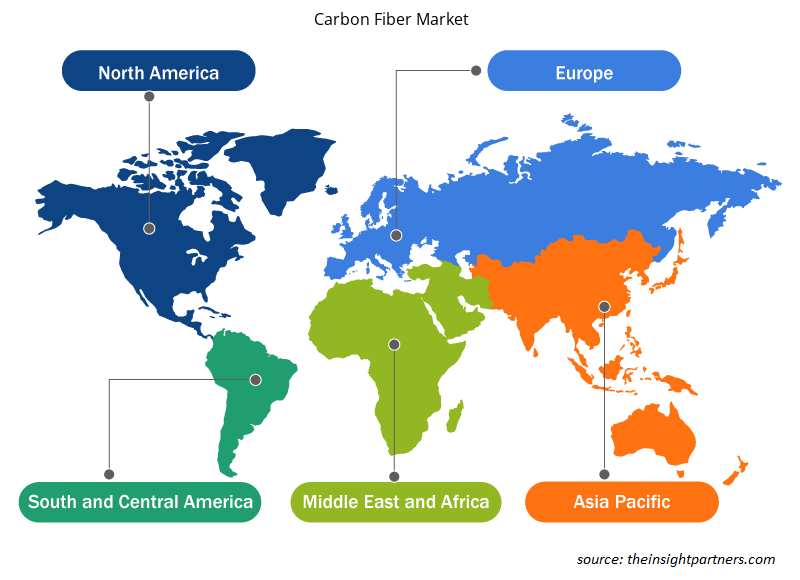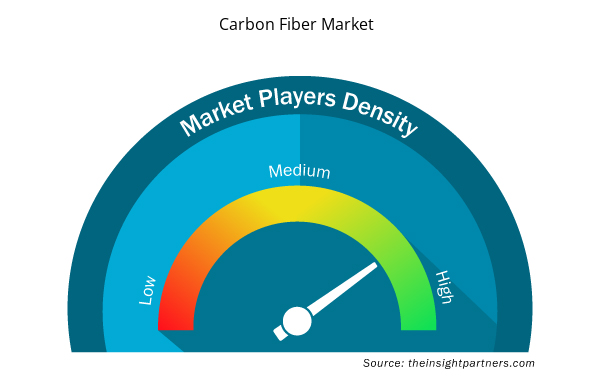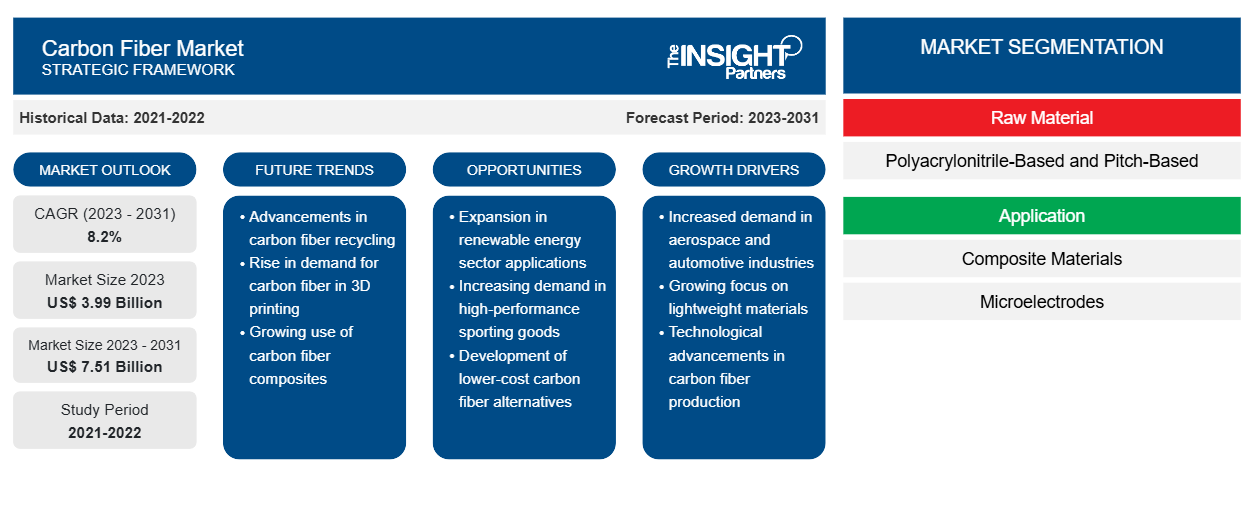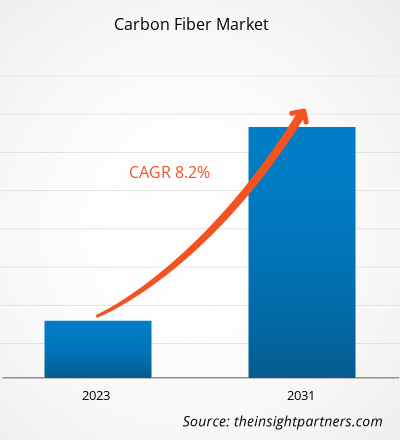炭素繊維市場規模は、2023年の39億9,000万米ドルから2031年には75億1,000万米ドルに達すると予測されています。市場は2023年から2031年の間に8.2%のCAGRを記録すると予想されています。航空宇宙、自動車、スポーツ用品、工業部門からの需要の高まりにより、将来的には炭素繊維市場に新たなトレンドが生まれる可能性があります。
炭素繊維市場分析
カーボンファイバーは、優れた機械的強度、剛性、耐熱性、耐薬品性を備えています。スチールやアルミニウムよりも大幅に軽量でありながら、相対的に優れた強度を示します。このため、カーボンファイバーは、航空宇宙、自動車、スポーツ用品、工業分野など、軽量化が重要な用途で人気の素材となっています。さまざまな分野の産業が、軽量で耐久性があり、エネルギー効率の高い素材を求めるニーズを満たすためにカーボンファイバー複合材を採用するケースが増えているため、カーボンファイバー市場は今後も成長を続けると予想されています。カーボンファイバー製造プロセスの技術的進歩とコスト効率の高い生産技術の開発も、今後数年間の市場拡大に貢献する可能性があります。
炭素繊維市場の概要
自動車メーカーは、高い機械的強度と引張強度を持つ軽量自動車部品の製造のために、革新的で高品質の材料を求めています。炭素繊維は、軽量自動車部品の製造に最も適した材料の 1 つと考えられています。さらに、炭素繊維強化複合材は、重量が重く燃費効率が低下する鋼やアルミニウムの部品の代替品として不可欠な材料として使用されています。自動車業界で炭素繊維を使用することで燃費が向上し、エネルギーが節約され、二酸化炭素排出量が最小限に抑えられます。大手自動車メーカーは部品の製造に炭素繊維を使用しています。たとえば、エアバス A350 ユニットは 52% の炭素繊維強化ポリマー (CFRP) で構成されていますが、BMW i3 ユニットは主に CFRP シャーシで構成されています。
要件に合わせてレポートをカスタマイズする
このレポートの一部、国レベルの分析、Excelデータパックなど、あらゆるレポートを無料でカスタマイズできます。また、スタートアップや大学向けのお得なオファーや割引もご利用いただけます。
- このレポートの主要な市場動向を入手してください。この無料サンプルには、市場動向から見積もりや予測に至るまでのデータ分析が含まれます。
炭素繊維市場の推進要因と機会
風力エネルギー産業における軽量タービンブレードの採用が炭素繊維市場の成長を促進
再生可能資源の利用が好まれるようになり、風力発電所の設置が急増しています。さまざまな国で広大な土地や沿岸地域が風力タービンの操業に割り当てられています。炭素繊維は風力エネルギー産業で重要な役割を果たしています。今日、風力タービンメーカーは、炭素繊維などの高度な複合材料を使用して、より効率的で長く軽量のブレードを製造しています。タービンブレードの長さを延長すると、より多くのエネルギーを生成できます。大型ブレードは通常、剛性と先端のたわみに重点を置いて設計されます。それでも、炭素繊維の高剛性は、ブレードのたわみを低く抑えることに貢献します。したがって、複合炭素繊維で作られた大型タービンブレードでは、ブレードとタワーの間の所定のクリアランスでタワーの直径を大きくすることができます。炭素繊維は、ブレードのバックボーンであるスパーキャップにも使用されます。
カーボンファイバーは、ガラス繊維に比べて剛性が高く密度が低いため、風力タービンの設計においてガラス繊維の効果的な代替品であることが証明されており、より薄く、剛性が高く、軽いブレードを実現できます。ただし、カーボンファイバー製のブレードは、損傷許容度、圧縮強度、極限ひずみが比較的低いです。そのため、カーボンファイバーは風力タービンブレードの製造に最も一般的に使用されています。Vestas Wind Systems A/SやGamesa Technology Corpなどの企業は、ブレードの選択的な構造部品にカーボンファイバーを使用し、タービンシステム全体で軽量ブレードの利点を活用しています。ブレードが軽量であれば、タービンとタワーのコンポーネントの堅牢性が低くなるため、最終的には全体的なコストが削減されます。したがって、風力エネルギー業界で軽量タービンブレードの使用が急増すると、カーボンファイバーの需要が高まり、市場の成長が促進されます。
3Dプリントにおけるカーボンファイバーの需要増加が成長機会を生み出す
近年、3Dプリンターは多品種少量生産技術として注目を集めています。3Dプリントカーボンファイバーは最も人気のある積層造形技術です。カーボンファイバー強化プラスチックを3Dプリントフィラメントに追加することで、プリント部品の弾力性と強度が向上します。これらの複合材料は、金属よりも軽量であるにもかかわらず、金属よりもはるかに高い強度を備えています。さらに、カーボンファイバーをプラスチック樹脂と混合して、3Dプリント部品の機械的特性を強化することもできます。カーボンファイバー強化複合材料を使用した3Dプリントは、最も人気のある積層造形技術の1つです。積層造形技術は、潜在的なコスト削減、部品の複雑さの増加、機能統合などの利点により、大きな注目を集めています。カーボンファイバーは、レーシングカー、建設資材、スポーツ用品、ドローン、日用品などの3Dプリント材料の開発に使用されています。一部の大手企業は、カーボンファイバーベースの3Dプリント複合材料の発売に注力しています。
炭素繊維市場レポートのセグメンテーション分析
炭素繊維市場分析を提示するために考慮される主要なセグメントは、製品と最終用途です。
- 原材料に基づいて、炭素繊維市場はポリアクリロニトリルベースとピッチベースに分類されます。ポリアクリロニトリルベースのセグメントは、2023年に大きな市場シェアを占めました。
- 用途別に見ると、炭素繊維市場は複合材料、マイクロ電極、その他に分類されます。複合材料セグメントは2023年に最大の市場シェアを占めました。
- 最終用途産業別に見ると、炭素繊維市場は自動車、航空宇宙・防衛、建築・建設、スポーツ用品、風力エネルギー、繊維、海洋などに分類されます。2023年には自動車部門が市場で最大のシェアを占めました。
炭素繊維市場シェア分析(地域別)
炭素繊維市場レポートの地理的範囲は、主に北米、アジア太平洋、ヨーロッパ、中東およびアフリカ、南米および中米の 5 つの地域に分かれています。
アジア太平洋地域は、炭素繊維市場を独占しています。アジア太平洋地域の人々の可処分所得が高いため、商用車や乗用車の販売が急増し、車両のニーズが高まっています。さらに、アジア太平洋地域の大手自動車 OEM による投資の増加と EV 製造能力の向上により、この地域の従来型車両と電気自動車の需要が高まっています。アジア太平洋地域の車両部品製造業界の成長は、この地域の自動車産業の成長に起因しています。炭素繊維は、車両用複合材の製造に広く使用されています。したがって、自動車産業の成長に伴い、炭素繊維の需要も地域全体で増加しています。
炭素繊維市場の地域別分析
予測期間を通じて炭素繊維市場に影響を与える地域的な傾向と要因は、Insight Partners のアナリストによって徹底的に説明されています。このセクションでは、北米、ヨーロッパ、アジア太平洋、中東、アフリカ、南米、中米にわたる炭素繊維市場のセグメントと地理についても説明します。

- 炭素繊維市場の地域別データを入手
炭素繊維市場レポートの範囲
| レポート属性 | 詳細 |
|---|---|
| 2023年の市場規模 | 39億9000万米ドル |
| 2031年までの市場規模 | 75億1000万米ドル |
| 世界のCAGR(2023年~2031年) | 8.2% |
| 履歴データ | 2021-2022 |
| 予測期間 | 2023-2031 |
| 対象セグメント | 原材料別
|
| 対象地域と国 | 北米
|
| 市場リーダーと主要企業プロフィール |
|
市場プレーヤーの密度:ビジネスダイナミクスへの影響を理解する
炭素繊維市場は、消費者の嗜好の変化、技術の進歩、製品の利点に対する認識の高まりなどの要因により、エンドユーザーの需要が高まり、急速に成長しています。需要が高まるにつれて、企業は提供を拡大し、消費者のニーズを満たすために革新し、新たなトレンドを活用し、市場の成長をさらに促進しています。
市場プレーヤー密度とは、特定の市場または業界内で活動している企業または会社の分布を指します。これは、特定の市場スペースに、その市場規模または総市場価値に対してどれだけの競合相手 (市場プレーヤー) が存在するかを示します。
炭素繊維市場で事業を展開している主要企業は次のとおりです。
- SGLカーボンSE
- ダウアクサ・アドバンスト・コンポジット・マテリアル・インダストリーズ株式会社
- フォルモサプラスチックス株式会社
- ヘクセル株式会社
- 暁星先端材料株式会社
- クレハ株式会社
免責事項:上記の企業は、特定の順序でランク付けされていません。

- 炭素繊維市場のトップキープレーヤーの概要を入手
炭素繊維市場のニュースと最近の動向
炭素繊維市場は、主要な企業出版物、協会データ、データベースを含む一次調査と二次調査後の定性的および定量的データを収集することによって評価されます。以下は、炭素繊維市場の動向の一覧です。
- 東レ株式会社は本日、1平方インチあたり1,160キロポンド(Ksi)という世界最高強度を誇るTORAYCA T1200炭素繊維を開発したと発表しました。この新製品は、炭素繊維強化プラスチック材料の軽量化による環境フットプリントの削減に大きく貢献します。この繊維は、強度重視の用途に新たな性能の領域を開きます。その潜在的用途は、航空構造や防衛から代替エネルギーや消費者製品まで多岐にわたります。(出典:東レ・アドバンスト・コンポジッツ、プレスリリース、2023年)
- SGL Carbonは、JEC World 2023で新しい50kカーボンファイバーを発表します。新しいSIGRAFIL C T50-4.9/235カーボンファイバーは、一般的な圧力容器設計の高強度要件を満たし、高い伸び容量を発揮します。また、高強度と伸びを必要とする市場セグメントでのさらなる用途も可能にします。(出典: SGL Carbon、プレスリリース、2023年)
炭素繊維市場レポートの対象範囲と成果物
「炭素繊維市場の規模と予測(2021〜2031年)」レポートでは、以下の分野をカバーする市場の詳細な分析を提供しています。
- 対象範囲に含まれるすべての主要市場セグメントの世界、地域、国レベルでの市場規模と予測
- 市場の動向(推進要因、制約、主要な機会など)
- 今後の主な動向
- ポーターの5つの力とSWOT分析の詳細
- 主要な市場動向、主要プレーヤー、規制、最近の市場動向を網羅した世界および地域の市場分析
- 市場集中、ヒートマップ分析、主要プレーヤー、最近の動向を網羅した業界の状況と競争分析
- 詳細な企業プロフィール
- 過去2年間の分析、基準年、CAGRによる予測(7年間)
- PEST分析とSWOT分析
- 市場規模価値/数量 - 世界、地域、国
- 業界と競争環境
- Excel データセット



Report Coverage
Revenue forecast, Company Analysis, Industry landscape, Growth factors, and Trends

Segment Covered
This text is related
to segments covered.

Regional Scope
North America, Europe, Asia Pacific, Middle East & Africa, South & Central America

Country Scope
This text is related
to country scope.
Trends and growth analysis reports related to Chemicals and Materials : READ MORE..
The Insight Partners performs research in 4 major stages: Data Collection & Secondary Research, Primary Research, Data Analysis and Data Triangulation & Final Review.
- Data Collection and Secondary Research:
As a market research and consulting firm operating from a decade, we have published and advised several client across the globe. First step for any study will start with an assessment of currently available data and insights from existing reports. Further, historical and current market information is collected from Investor Presentations, Annual Reports, SEC Filings, etc., and other information related to company’s performance and market positioning are gathered from Paid Databases (Factiva, Hoovers, and Reuters) and various other publications available in public domain.
Several associations trade associates, technical forums, institutes, societies and organization are accessed to gain technical as well as market related insights through their publications such as research papers, blogs and press releases related to the studies are referred to get cues about the market. Further, white papers, journals, magazines, and other news articles published in last 3 years are scrutinized and analyzed to understand the current market trends.
- Primary Research:
The primarily interview analysis comprise of data obtained from industry participants interview and answers to survey questions gathered by in-house primary team.
For primary research, interviews are conducted with industry experts/CEOs/Marketing Managers/VPs/Subject Matter Experts from both demand and supply side to get a 360-degree view of the market. The primary team conducts several interviews based on the complexity of the markets to understand the various market trends and dynamics which makes research more credible and precise.
A typical research interview fulfils the following functions:
- Provides first-hand information on the market size, market trends, growth trends, competitive landscape, and outlook
- Validates and strengthens in-house secondary research findings
- Develops the analysis team’s expertise and market understanding
Primary research involves email interactions and telephone interviews for each market, category, segment, and sub-segment across geographies. The participants who typically take part in such a process include, but are not limited to:
- Industry participants: VPs, business development managers, market intelligence managers and national sales managers
- Outside experts: Valuation experts, research analysts and key opinion leaders specializing in the electronics and semiconductor industry.
Below is the breakup of our primary respondents by company, designation, and region:

Once we receive the confirmation from primary research sources or primary respondents, we finalize the base year market estimation and forecast the data as per the macroeconomic and microeconomic factors assessed during data collection.
- Data Analysis:
Once data is validated through both secondary as well as primary respondents, we finalize the market estimations by hypothesis formulation and factor analysis at regional and country level.
- Macro-Economic Factor Analysis:
We analyse macroeconomic indicators such the gross domestic product (GDP), increase in the demand for goods and services across industries, technological advancement, regional economic growth, governmental policies, the influence of COVID-19, PEST analysis, and other aspects. This analysis aids in setting benchmarks for various nations/regions and approximating market splits. Additionally, the general trend of the aforementioned components aid in determining the market's development possibilities.
- Country Level Data:
Various factors that are especially aligned to the country are taken into account to determine the market size for a certain area and country, including the presence of vendors, such as headquarters and offices, the country's GDP, demand patterns, and industry growth. To comprehend the market dynamics for the nation, a number of growth variables, inhibitors, application areas, and current market trends are researched. The aforementioned elements aid in determining the country's overall market's growth potential.
- Company Profile:
The “Table of Contents” is formulated by listing and analyzing more than 25 - 30 companies operating in the market ecosystem across geographies. However, we profile only 10 companies as a standard practice in our syndicate reports. These 10 companies comprise leading, emerging, and regional players. Nonetheless, our analysis is not restricted to the 10 listed companies, we also analyze other companies present in the market to develop a holistic view and understand the prevailing trends. The “Company Profiles” section in the report covers key facts, business description, products & services, financial information, SWOT analysis, and key developments. The financial information presented is extracted from the annual reports and official documents of the publicly listed companies. Upon collecting the information for the sections of respective companies, we verify them via various primary sources and then compile the data in respective company profiles. The company level information helps us in deriving the base number as well as in forecasting the market size.
- Developing Base Number:
Aggregation of sales statistics (2020-2022) and macro-economic factor, and other secondary and primary research insights are utilized to arrive at base number and related market shares for 2022. The data gaps are identified in this step and relevant market data is analyzed, collected from paid primary interviews or databases. On finalizing the base year market size, forecasts are developed on the basis of macro-economic, industry and market growth factors and company level analysis.
- Data Triangulation and Final Review:
The market findings and base year market size calculations are validated from supply as well as demand side. Demand side validations are based on macro-economic factor analysis and benchmarks for respective regions and countries. In case of supply side validations, revenues of major companies are estimated (in case not available) based on industry benchmark, approximate number of employees, product portfolio, and primary interviews revenues are gathered. Further revenue from target product/service segment is assessed to avoid overshooting of market statistics. In case of heavy deviations between supply and demand side values, all thes steps are repeated to achieve synchronization.
We follow an iterative model, wherein we share our research findings with Subject Matter Experts (SME’s) and Key Opinion Leaders (KOLs) until consensus view of the market is not formulated – this model negates any drastic deviation in the opinions of experts. Only validated and universally acceptable research findings are quoted in our reports.
We have important check points that we use to validate our research findings – which we call – data triangulation, where we validate the information, we generate from secondary sources with primary interviews and then we re-validate with our internal data bases and Subject matter experts. This comprehensive model enables us to deliver high quality, reliable data in shortest possible time.


 このレポートの無料サンプルを入手する
このレポートの無料サンプルを入手する